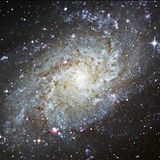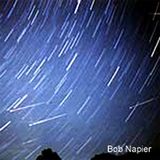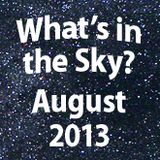
Friday, August 9
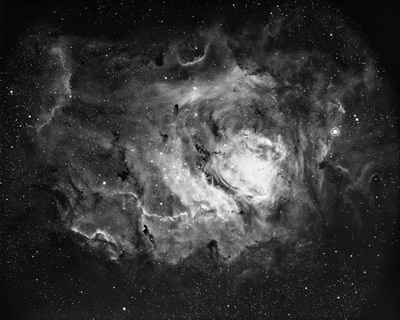
M8 - Credit: NOAO/AURA/NSF
Tonight let's study one of the grandest of all solar winds as we seek out an area about three fingerwidths above the teapot's spout of Sagittarius where we'll find the magnificent Messier 8 (Right Ascension: 18:03.8 - Declination: -24 :23), also known as the "Lagoon Nebula."
Visible to the unaided eye as a hazy spot in the Milky Way, M8 is fantastic in binoculars, and an area truly worth studying in any size scope. This 5,200 light-year area of emission, reflection and dark nebulae has a rich history, too. Its involved star cluster - NGC 6530 - was first discovered by John Flamsteed around 1680, and the nebula by Jean-Baptiste Le Gentil in 1747. Cataloged by Louis Lacaille as "III.14" about 12 years before Messier listed it as number 8, its brightest region was recorded by John Herschel and the dark nebulae were discovered by E.E. Barnard.
Tremendous areas of star birth are taking place in this region; while young, hot stars excite the gases in an area known as the "Hourglass," around Herschel star 36 and 9 Sagittarius. Look closely around cluster NGC 6530 for Barnard dark nebulae B89 and B296 at the nebula's southern edge. No matter how long you chose to swim in the "Lagoon" you will surely find more and more things to delight both the mind and the eye!
Saturday, August 10
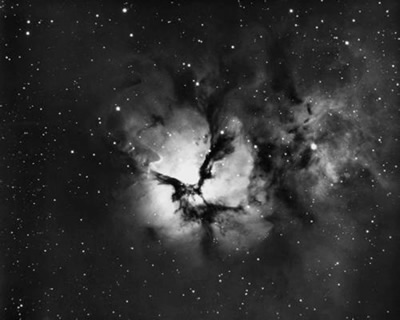
M20 - Credit: NOAO/AURA/NSF
Tonight we'll return to the nebula hunt as we head about a fingerwidth north and just slightly west of M8 for the "Trifid Nebula," or Messier 20.
M20 (Right Ascension: 18:02.3 - Declination: -23:02) was discovered by Charles Messier on June 5, 1764, and much to his credit, he described it as a cluster of stars encased in nebulosity. This is truly a wonderful observation since the Trifid could not have been easy to find given his equipment. Some 20 years later, William Herschel (although he usually avoided repeating Messier objects) found M20 of enough interest to assign separate designations to parts of this nebula - IV.41, V.10, V.11, V.12. The word "Trifid" was used to describe its beauty by John Herschel.
While M20 is a very tough call in binoculars, it is not impossible with good conditions to see the light of an area that left its home nearly a millennium ago. Even smaller scopes will pick up this round, hazy patch of both emission and reflection, but you will need aversion to see the dark nebula which divides it. This was cataloged by E.E. Barnard as B85. Larger telescopes will find the Trifid as one of the very few objects that actually appears in the eyepiece much as it does in photographs — with each lobe containing beautiful details, rifts and folds best seen at lower powers. Look for its cruciform star cluster and its fueling multiple star system while you enjoy this triple treat tonight!
Sunday, August 11
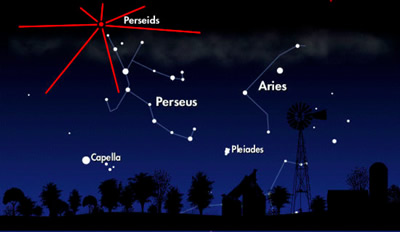
Perseid Meteor Shower: Credit: NASA
Tonight after midnight is the beginning phase of the Perseid Meteor Shower, and this year there's no Moon in the later evening sky to contend with! Now let's sit back and talk about the Perseids while we watch...
The Perseids are undoubtedly the most famous of all meteor showers and never fail to provide an impressive display. Their activity appears in Chinese history as far back as 36 AD. In 1839, Eduard Heis was the first observer to give an hourly count, and discovered their maximum rate was around 160 per hour at that time. He, and other observers, continued their studies in subsequent years to find that this number varied.
Giovanni Schiaparelli was the first to relate the orbit of the Perseids to periodic comet Swift-Tuttle (1862 III). The fall rates have both risen and fallen over the years as the Perseid stream was studied more deeply, and many complex variations were discovered. There are actually four individual streams derived from the comet's 120 year orbital period which peak on slightly different nights, but tonight through tomorrow morning at dawn is our accepted peak.
Meteors from this shower enter Earth's atmosphere at a speed of 60 km/sec (134,000 miles per hour), from the general direction of the border between the constellations Perseus and Cassiopeia. While they can be seen anywhere in the sky, if you extend their paths backward, all the true members of the stream will point back to this region of the sky. For best success, get away from city lights, position yourself so you are generally facing northeast and get comfortable. If you are clouded out, don't worry. The Perseids will be around for a few more days yet, so continue to keep watch!
Wishing you clear skies...
Tammy Plotner is a professional astronomy author, President Emeritus of Warren Rupp Observatory and retired Astronomical League Executive Secretary. She's received a vast number of astronomy achievement and observing awards, including the Great Lakes Astronomy Achievement Award, RG Wright Service Award and the first woman astronomer to achieve Comet Hunter's Gold Status


